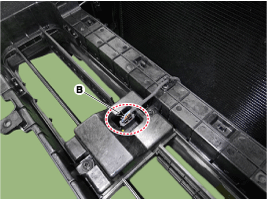Hyundai Genesis: Cooling System / Active Air Flap(AAF) Repair procedures
Hyundai Genesis (DH) 2013-2016 Service Manual / Engine Mechanical System / Cooling System / Active Air Flap(AAF) Repair procedures
| Removal and Installation |
| 1. |
Disconnect the battery "-" terminal from the trunk room. |
| 2. |
Remove the front bumper.
(Refer to Body - "Front Bumper Cover") |
| 3. |
Disconnect the connector and remove the lower air guard (A).
|
| 4. |
Remove the active air flap (AAF) assembly (A) and disconnect the connector (B).
|
| 5. |
To install, reverse the removal procedure. |
| 6. |
After installation, perform the "Actuation test" using GSD to check on the system. |
| Disassembly |
| 1. |
Loosen the fixing screw and then remove the active air flap rear cover (A).
|
| 2. |
Remove the active air flap actuator cover (A).
|
| 3. |
Remove the active air link (A).
|
| 4. |
Remove the active air actuator (A).
|
| 5. |
To install, reverse the removal procedure. |
 Active Air Flap(AAF) Schematic Diagrams
Active Air Flap(AAF) Schematic Diagrams
Schematic Diagram
Circuit Diagram
...
 Active Air Flap(AAF) Troubleshooting
Active Air Flap(AAF) Troubleshooting
Troubleshooting
SymptomsPossible CausesRemedyWarning illuminated"Check active air flap system"Active Air Flap System Fail(Flap stuck)• Inspect the flap and remove the foreign substance• Check ...
Other information:
Hyundai Genesis (DH) 2013-2016 Owners Manual: If the engine will not start
If the engine doesn't turn over or turns over slowly Be sure the shift lever is in N (Neutral) or P (Park). The engine starts only when the shift lever is in N (Neutral) or P (Park). Check the battery connections to be sure they are clean and tight. Turn on the interior light. ...
Hyundai Genesis (DH) 2013-2016 Service Manual: Front Seat Belt Buckle Components and Components Location
Component Location 1. Front seat belt buckle ...
© 2013-2025 www.hgenesisdh.com







